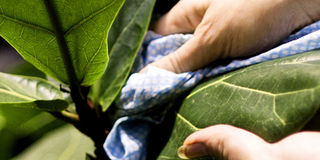CARING FOR YOUR INDOOR PLANTS

You need to clean your plants often to open up the stomatas
How can you go about caring for your indoor plants after buying them? Common problems are yellowing and drying leaves, as well as limpness.
Joseph Kaka, who sells flowers along Mukwano Road, tells us how:
Indoor plants require much time to look after. If you don’t have time to look after plants, you will not be able to manage them.
Plants are like human beings. If you fail to feed them, they will die.
Give them what they need. It may be water, plant food, good soil or they may need spraying. Check for what might be lacking at a particular moment and provide it.
How to do it
Caring in simple terms means cleaning your plants. Indoor plants have to be cleaned at intervals. It can be once a month, a week or every day, depending on the type of plant.
Cleaning
Clean them with a soft cloth. Prepare soapy water, deep your cloth in it and rub it on the leaves, especially for the non-flowering ones.
They need to be washed, to unblock the stomata, so as to breathe and live properly.
Feeding
If you intend to give them plant food, they cannot absorb it when the air stomata are blocked. After cleaning, dry them. Then get soluble solutions like plant food, according to the type of plant and apply it on the leaves. This will help keep the leaves clean, neat and healthy.
Most beautiful indoor plants depend on plant food. Every plant has its specific type of plant food. Go to a supermarket and ask for plant food according to the name of the plant. Get to know the names of the plants.
Prices of plant food range from Shs.10,000 to Shs100,000, depending on the type of plant. The type of application depends on the type of plant food. Some are applied on the leaves and others in the soil, so that it can be absorbed through the roots.
Watering
Water them at intervals. The flowering ones need a lot of water. Water them two to three times a week. Non-flowering plants need less water. Water them once a week or once a month, depending on the type of plant.
Treatment
Treat them by spraying. Spraying is not a must. Do it only when there is an infection. If pests have attacked it, find out the type, look for the right pesticide and spray them. For fungi, look for fungicides. Indoor plants are mostly attacked by fungi because of the usually high humidity levels in houses.
Re-potting
Re-potting is usually annual, but it also depends on the type of plant. Some plants will need re-potting after 10 years.
Check to see whether the plant needs re-potting and do it immediately. If the plant is not growing, there may be reasons for this. One of them may be because it needs re-potting.
To re-pot means to change the soil. Take the plant out of the pot, trim out most of the roots, take out the old soil and put new soil: and re-plant it. Do it the way you had before – in layers.
If the nursery attendant told you the plant should grow to your height and it has not after one or two years, there could be a problem. Re-pot it to give it a new lease of life.’
Does this seem too time-consuming? Then let your plants be part of the furniture in your house.
Every time you give the chairs a wipe-down, do the same to the leaves of your plants and water accordingly.




